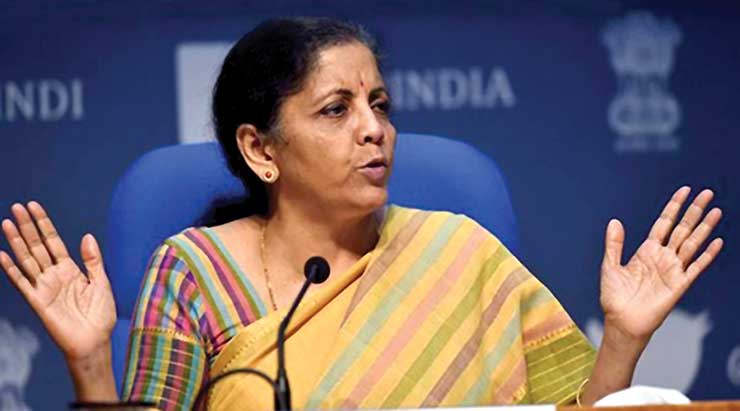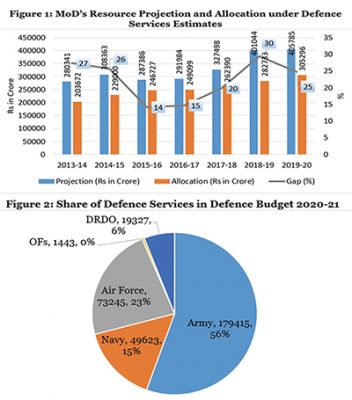
Presenting the Union Budget for FY 2020-2021, Finance Minister Nirmala Sitharaman made no mention of defence. All she mentioned was “national security is a top priority for the government.” She may repeat this while presenting the next union budget on February 1 or at best add that there will be no shortage of funds for defence – something which defence ministers have been parroting without substance.
For FY 2020-2021, Rs 323,053 crore were allocated for the three Services less pensions, which is 1.43 per cent of GDP – lowest by the BJP-led government since 2014 and lowest since 1960s; so much for national security being top priority. Following the Chinese aggression in May-June 2020, government reportedly allotted some additional funds under revenue in December but considering the imports reported in media since June 2020 including plugging the ammunition and equipment shortages plus the massive troop mobilization and allied logistics, several ongoing military projects under capital outlay will be adversely affected.
Despite media rhetoric, successive defence budgets have turned out negative in actual terms because the so called hike barely meet inflation costs. Parliament Standing Committees for Defence have repeatedly pointed out poor defence funding and equipment holding state like in 2018 but Sitharaman, then defence minister, rubbished the report saying there were no shortages – what a shame! The only result was that Chairman of the Parliament Standing Committees for Defence, Major General BC Khanduri from BJP was eased out from the post.
In its year-end review of 2020, the Ministry of Defence (MoD) continues to maintain China “amassed a large number of troops along the Line of Actual Control (LAC)”, avoiding the fact that chunks of strategic territory have been intruded into and occupied by China. We have conveniently construed that ‘Actual’ in LAC means actual on particular day, making the LAC flexible. The ploy earns plaudits at home but only encourages enemies.
The current standoff will likely be a long one, perhaps taking a semi-permanent form. Already there is talk of another Strike Corps likely to be moved to the border with China. Signals from China are not good with PLA consolidation in Eastern Ladakh and President Xi Jinping having accumulated maximum power asking the PLA to be ready for war at short notice. Discovery of a newly built Chinese village in Arunachal Pradesh has led some to say that China will continue to slice territory like this and does not want confrontation. But that is like the ostrich burying its head in sand. China’s enhanced combat potential includes weapon platforms like underwater drones and the CH-5 drone with flight time of 60 hours and range of over 7,000 km. China’s first Type 075 landing helicopter dock ship is being commissioned in 2021.
China’s defence budget in 2020 was expected to rise by 6.6 per cent – Yuan 1.268 trillion (US$178.16 billion), with China being the only major economy with positive growth rate last year. China’s defence expenditure cannot be matched but increasing China threat has caused affected countries to hike their defence budgets. India has witnessed periodic calls to reduce the defence budget because we view ‘defence budget’ and ‘defence expenditure’ and haven’t balanced security and economy in absence of a national security strategy.
If defence means only the Army, Navy and Air Force, then shift all other entities under MoD to another ministry and see how drastically our defence expenditure comes down. Look at the funds guzzled by the DRDO-OFB-DPSUs compared to their output. Yet the goose that lays ‘golden eggs’ for the ‘deep state’ is not to be disturbed. That is why the internal report by the Army to MoD saying funds spent on faulty ammunition during 2014-2020 could have bought 100 x 155mm medium artillery guns is brushed under the carpet and so was supply of 1,00,00,000 faulty rounds of indigenous Tavor ammunition supplied last year. These are just two small examples.
The Department of Military Affairs (DMA) has been created in MoD with a toothless CDS, with defence policy, power and major financial dealings under the Defence Secretary. Isn’t what is vested in Defence Secretary not “military affairs”? Not surprising then that the confused CDS prefers to attend a private school function over laying a wreath at the war memorial on Navy Day and keeps visiting forward areas without any operational role assigned to his appointment.
There is perpetual hue and cry over the ‘enormous’ defence pension bill and the next volley will be let off moment the next budget is announced. The ‘deep state’ is craftily playing this narrative, deliberately remaining silent about other ministries. Fact is that the difference between IAS/IPS/CAPF and Defence over a period of 10 years is mere nine per cent. Why then the pressure to cut defence pensions when there is none on others?
We have a ridiculous ratio of 1:3 for civilian defence employees versus uniformed personnel. Pensions are grossly skewed as more than one third military pension budget is disbursed to civilians though they account for around a fifth of all pensioners. On an average a civilian defence employee is five times expensive than his uniformed counterpart. To top this, government wants to ‘increase’ the civilian defence employees who get faster promotions and therefore higher pays. Without touching this aspect, the CDS has been recommending extension of service for all ranks by two years, three years ‘tour of duty’ (on political nudging?) and the like, but not fighting for absorption of retiring personnel into CAPF as second career as recommended by successive pay commissions.
There have been suggestions that Army should be allowed to raise finances through enterprises like the PLA and Pakistani army. Do we really want that? Before Sitharaman opened the Army Cantonments, it was inserted in media that Army was looking at gaining Rs 1,00,000 crore that could be used military modernization from cantonment land encroached by a multitude of politicians, building houses and running businesses through associates. Who would know the value better than Sitharaman whose spouse was overseeing an enterprise on defence land, as was reported in media. But then Sitharaman bluntly announced that not one single penny will come to the defence budget from this.

Presently, there is news in media about government asking views for ‘closing’ down all cantonments – Sitharaman’s crusade against the military? Hopefully this will not happen because of the adverse effects. But if government has already made up its mind then why the drama – just ask the CDS who may agree without any hesitation whatsoever given his performance since appointed Army Chief and later CDS.
If we are serious about national security and cutting down defence expenditure, following needs to be done:
Define a national security strategy, for which government had tasked the NSA in 2019, and undertake an immediate strategic defence review in order to stop shadow boxing.
Reorganize the MoD by bringing the CDS directly under the Defence Minister / MoS (Defence), appointing CDS as single point advisor to the Prime Minister. DMA and Department of Defence (DoD) should be merged and and placed under CDS. This will be true ‘political’ control over the military. Bureaucratic control over the military since past seven decades plus must go. Politicians must acknowledge that military will give them correct advice – better than bureaucrats.
The deep state would argue that MoD has just been reorganized and should run for a few years before further change. But that would be naive because the changes made so far have made little difference. A comprehensive reorganization is warranted.
The Department of Defence Production (DoPD) should be transferred to the Ministry of Heavy Industries and Public Enterprises. If unavoidable, the goose can keep laying golden eggs but not as part of MoD.
Privatize to the extent possible the DRDO-OFB-DPSUs and corporatised the residual without worrying about worker unions and vote banks. This is the best time, there being no viable opposition. Government defence-industrial complexes are viable in communist countries with strict controls. In democracies like the US, UK, France, Japan and South Korea, private industry is at the forefront of defence production.
The costs of regularising the encroachments and occupation of defence land since opening of the cantonments must be paid by the encroachers whether politicians or their associates and go towards military modernization.
Promotions, perks and cadres review of civilian defence employees should be brought at par with combatants or former category combatised. This will reduce expenses and ensure better cooperation.
Second career for retiring military personnel must be seriously looked into including as recommended by various pay commissions, burying the usual lip service.
Expansion of Territorial Army should be seriously examined.
India needs to systematically build ‘hard power’ in the next five-seven years, in addition to holistic asymmetric capabilities. If we do not do so, we will continue to run around in circles in situations like the Chinese aggressions in 1962 and 2020 and the 1999 Kargil intrusions. If defence allocations for the next financial years are similar to the last years, we may find ourselves in dire straits in future.
-The author is a veteran of Indian Army. Views expressed are personal








